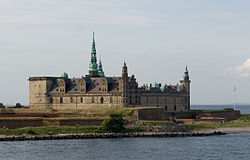This is an old revision of this page, as edited by LucienBOT (talk | contribs) at 15:39, 7 March 2011 (r2.6.4) (robot Adding: eu:Helsingør). The present address (URL) is a permanent link to this revision, which may differ significantly from the current revision.
Revision as of 15:39, 7 March 2011 by LucienBOT (talk | contribs) (r2.6.4) (robot Adding: eu:Helsingør)(diff) ← Previous revision | Latest revision (diff) | Newer revision → (diff) Place in Capital Region, Denmark| Elsinore Helsingør | |
|---|---|
 Kronborg Castle Kronborg Castle | |
| Country | Denmark |
| Region | Capital Region |
| Municipality | Helsingør Municipality |
| Established | 1420s |
| City charter | 17th century |
| Current municipality | 2007-01-01 |
| Government | |
| • Mayor | Henrik Møller |
| Population | |
| • Total | 46,189 |
| Time zone | UTC+1 (CET) |
| • Summer (DST) | UTC+1 (CEST) |
| Website | www.helsingorkommune.dk |

Helsingør (Template:IPA-da; also known as Elsinore in English) is a city and the municipal seat of Helsingør municipality on the northeast coast of the island of Zealand (Danish: Sjælland) in eastern Denmark. Helsingør has a population of 46,189 (1 January 2010) including the southern suburbs of Snekkersten and Espergærde. It is known internationally as the setting of William Shakespeare's Hamlet, whence the spelling 'Elsinore' originated.
History
The name is derived from the word "hals" meaning "neck" or "narrow strait", referring to the narrow strait (Øresund) between what is now Helsingør and Helsingborg, Sweden. The Rerum Danicarum Historica (1631) claims that the history of Helsingør can be traced back to 70 BC, but this information is highly dubious. The people were mentioned as Helsinger (which may mean "the people of the strait"), for the first time in King Valdemar the Victorious's Liber Census Daniæ from 1231, but they should not be confused with the Helsings of Hälsingland in Sweden. Placenames show that the Helsinger may have had their main fort at Helsingborg and a fortified landing place at Helsingør, to control the ferry route across the strait.
Before the Middle Ages Helsingør was just a marketplace where people sold goods. About 1200 AD the first church, Sct Olai Church, was built. A number of convents once surrounded the church, but now all that remains is the church building, today the cathedral of the Diocese of Helsingør. The oldest parts of the cathedral of Helsingør date back to the 13th century and tell us that the fishermen's village, as Helsingør was then, was a town of a certain importance. At least, there have always been some form of ferryboats crossing between Helsingør and Helsingborg.
Helsingør as we know it today was founded in the 1420s by the Danish king Eric of Pomerania. He established the Sound Dues in 1429 and built the castle 'Krogen', which was expanded in the 1580s and named Kronborg.
Kronborg Castle is the main tourist attraction. The play Hamlet has been performed a number of times in its courtyard.
The Swedish city of Helsingborg lies a short distance across the Øresund from Elsinore. European route E55 traverses the two cities; ferries connect the two sides. Still of some importance is the historical fact that the most southern "county" of Sweden, Skåne, were a part of Denmark until 1658 - followed by three wars. It may seem a long time ago today, but the short distance across Øresund aswell as the long way to Stockholm remains.
Districts
Centrum
- North: Grønnehave (Green Gardens), Højstrup and Marienlyst
- West: Sundparken, Grøningen, Nøjsomheden and Vapnagård
- South: Skotterup and Snekkersten.
International relations
See also: List of twin towns and sister cities in DenmarkTwin towns — sister cities
Helsingør is twinned with:
In fiction
- William Shakespeare's play Hamlet takes place at Kronborg Castle in Helsingør, which Shakespeare spelled "Elsinore".
- In the 1983 comedy Strange Brew, which is loosely based on Hamlet, the protagonists are given jobs at Elsinore Brewery.
- In Patrick O'Brian's Aubrey–Maturin series, Helsingør fires mortar shells at the heroes in book seven, The Surgeon's Mate, as they sail past on their way to a rendezvous in the Baltic.
- In Philip Roth's second Chapter of his novel Our Gang ('71), Trick E. Dixon in a fictive speech tries to claim Helsingør as US-territory and tries to convince the audience to occupy the area
- In Bret Easton Ellis's novel Lunar Park the street on which the character Bret Easton Ellis lives with his own father-son haunting issues is named Elsinore Lane.
- Several stories written by the Danish author Karen Blixen (or Isak Dinesen) take place in "Elsinore," including "The Supper at Elsinore" in her first published volume of stories, Seven Gothic Tales.
- A well-known poem by the Portuguese surrealist poet Mário Cesariny is named "You are welcome to Elsinore".
See also
References
- Notes
- BEF44: Population 1st January, by urban areas database from Statistics Denmark
- ^ "HELSINGØR TURISTBUREAU - VICTORIA DESIGN". www.visithelsingor.dk. Retrieved 21 October 2009.
- "Gdańsk Official Website: 'Miasta partnerskie'" (in Polish & English). © 2009 Urząd Miejski w Gdańsku. Retrieved 11 July 2009.
{{cite web}}: External link in|publisher=
External links
- Helsingør Tourist Bureau website
- Port of Helsingør
- Template:Wikitravel
- Helsingør municipality's official website (in Danish only)
- Helsingør Leksikon: Local history wiki (in Danish only)
| 30 most populous urban areas of Denmark | ||||||||||||||||||||||||||||||||||||||||||||||||||||||||||||||||||||||||||||||||||||||||||||||||
|---|---|---|---|---|---|---|---|---|---|---|---|---|---|---|---|---|---|---|---|---|---|---|---|---|---|---|---|---|---|---|---|---|---|---|---|---|---|---|---|---|---|---|---|---|---|---|---|---|---|---|---|---|---|---|---|---|---|---|---|---|---|---|---|---|---|---|---|---|---|---|---|---|---|---|---|---|---|---|---|---|---|---|---|---|---|---|---|---|---|---|---|---|---|---|---|---|
| as of 1 January 2022, according to Statistics Denmark, see table BEF44 at statbank.dk. | ||||||||||||||||||||||||||||||||||||||||||||||||||||||||||||||||||||||||||||||||||||||||||||||||
| ||||||||||||||||||||||||||||||||||||||||||||||||||||||||||||||||||||||||||||||||||||||||||||||||
| Note: The population figure for metropolitan Copenhagen includes Frederiksberg, Albertslund, Brøndby, Gentofte, Gladsaxe, Glostrup, Herlev, Hvidovre, Lyngby-Taarbæk, Rødovre, Tårnby and Vallensbæk municipalities; parts of Ballerup, Rudersdal and Furesø; Ishøj and Greve Strand. | ||||||||||||||||||||||||||||||||||||||||||||||||||||||||||||||||||||||||||||||||||||||||||||||||
| 50 most populous urban areas in the Nordic countries | ||||||||||||||||||||||||||||||||||||||||||||||||||||||||||||||||||||||||||||||||||||||||||||||||||||||||||||||||||||||||||||||||||||||||||||||||||||||||||||
|---|---|---|---|---|---|---|---|---|---|---|---|---|---|---|---|---|---|---|---|---|---|---|---|---|---|---|---|---|---|---|---|---|---|---|---|---|---|---|---|---|---|---|---|---|---|---|---|---|---|---|---|---|---|---|---|---|---|---|---|---|---|---|---|---|---|---|---|---|---|---|---|---|---|---|---|---|---|---|---|---|---|---|---|---|---|---|---|---|---|---|---|---|---|---|---|---|---|---|---|---|---|---|---|---|---|---|---|---|---|---|---|---|---|---|---|---|---|---|---|---|---|---|---|---|---|---|---|---|---|---|---|---|---|---|---|---|---|---|---|---|---|---|---|---|---|---|---|---|---|---|---|---|---|---|---|---|
| ||||||||||||||||||||||||||||||||||||||||||||||||||||||||||||||||||||||||||||||||||||||||||||||||||||||||||||||||||||||||||||||||||||||||||||||||||||||||||||
Categories: